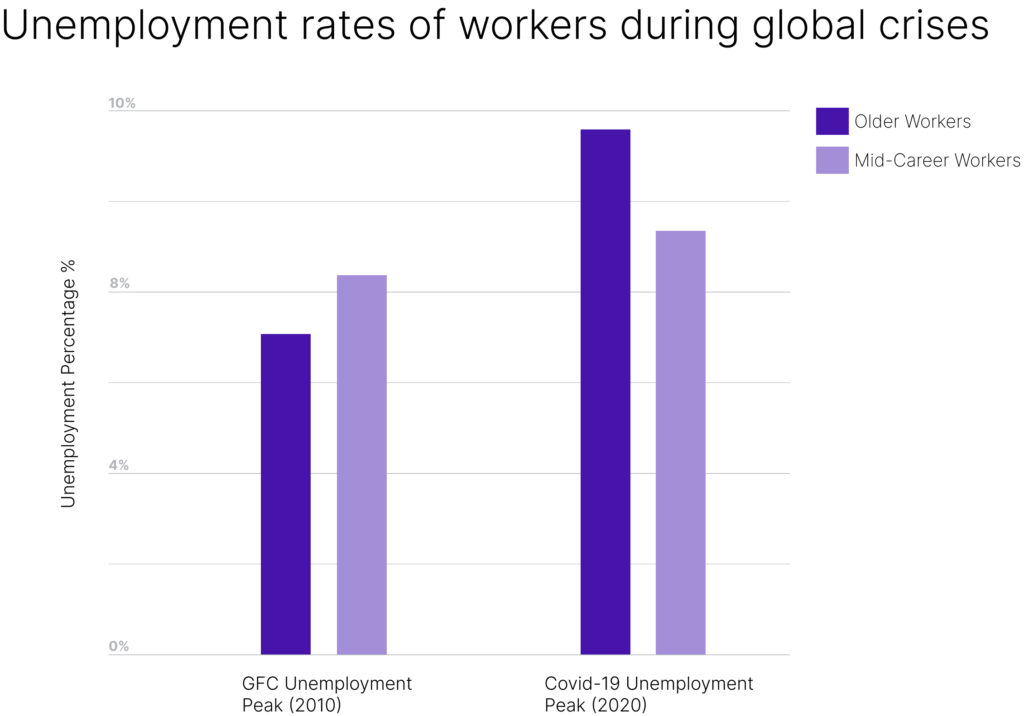What is Generational Diversity and why is it so important?
Generational diversity has become a hot topic recently, we’ll give you the lowdown on why it’s trending and what it means.

Generational diversity
Generational diversity is the idea that an inherently diverse team should include people who come from different generations. With at least four different generations currently in the workforce (Baby Boomers, Gen X, Millennial and Gen Z) there’s plenty of unique values, experiences and perspectives to be shared.
This generational mix is crucial to realising the benefits of a truly diverse team. Furthermore, hiring older workers (ages 55+) has become a prominent issue, this group has recently seen disproportionate inequality in the workforce.
Why everyone’s talking about it
During the pandemic many companies began to lay off employees as they adjusted for the new world. Unfortunately this had a significant effect on older workers, with employers laying off larger proportions of this group, who have since struggled to find meaningful employment.
For the first time since the 1970’s, older workers have consistently higher unemployment rates than mid-career workers (35-54). For reference, during the GFC older workers had a 7% unemployment rate, while mid-career faced 8.2%. Post-pandemic, older workers are stuck with a 9.7% unemployment rate and mid-careers at 8.6%. The roles have been reversed. It is also important to consider that those older workers who also belong to another diverse group — such as race, disability or gender — are significantly more impacted than older white male workers. For example, older women are 38% more likely to experience job loss.
To compound the issue, many older workers are prematurely retiring as a result of the layoffs and the difficulty in finding new work. This abrupt end of career effectively means companies are losing out on the vast knowledge and skill that comes with seniority, as older workers weren’t given the opportunity to engage in knowledge transfer activities such as mentoring.
Generational diversity is also a hot topic because Australia has just had their first successful Federal age discrimination case heard, bringing renewed interest to the issue from both an employer and legal standpoint.

Uncharted waters
Additionally, older workers face a range of other perceived biases in the workplace. Difficulty in keeping up with the rapid advancement of technology, progressive schools of thought on organisational culture are creating an environment where ageism is rampant.
The challenges that older workers are currently dealing with are, to some degree, the natural order of things. New generations bring in new ideas and perspectives and companies evolve. Those who were once the change-makers start to be left behind. However, the rise of retirement ages across the globe are causing workers to retire later, which is creating an environment where older workers are feeling ageism now more than ever, working in the workforce for longer than traditional natural progression allows. With the an ageing population and retirement ages continuing to climb, we’re entering uncharted territory when it comes to supporting older workers long-term. In the US, all of the net increase in employment since 2000 – about 17 million jobs – was among workers aged 55+.
New age
It’s not just the older workers who are at risk of under-representation in generational diversity. As Gen Z continues to file into the workforce with different expectations to, companies who are unwilling to change with time will find that they struggle to hire younger workers. Work from home, parental leave, and work/life balance are all examples of benefits that newer workers are coming to expect — and are unwilling to compromise.
Companies who struggle to attract and retain young workers will suffer greatly without the ideas and perspectives this generation brings to the table, as well as the efficiency they can help achieve through their tech-savvy ways.
Fostering generational diversity
We know it’s important to foster generational diversity within our teams but the challenge comes in realising the value each generation has, and how to bring the best out of them. Some strategies you can look to implement include:
1. Mentorship programs
Mentorship programs are a great way to foster continued, ongoing collaboration that if done right can be beneficial for both parties. Mentorship programs are especially crucial to give opportunities for knowledge transfer before employees retire.
2. Flexible work
Flexible working hours can be crucial for supporting older workers. Whether it’s the desire to work abroad or the flexibility to work part-time, they require plenty of rope, and the younger generations won’t work for you without it.
3. Learning and development
Offering employees opportunities to further their skills and fill in the gaps can be a great way to ensure that older workers aren’t squeezed out of the workforce. It’s important to be flexible and allow employees to have a say in their L&D budget, so workers are able to get real value out of any learning opportunities they have.
The future
Whilst we can’t say for sure where the future is headed, what we do know is generational diversity will become more important as we work for longer periods of our lives. With generation Alpha’s workforce debut just around the corner there will be a host of new issues around generational diversity to figure out, as concerns around their technology literacy rise.
What we do know, is that fostering a culture of acceptance and inherent diversity is incredibly beneficial for companies, humans and society.